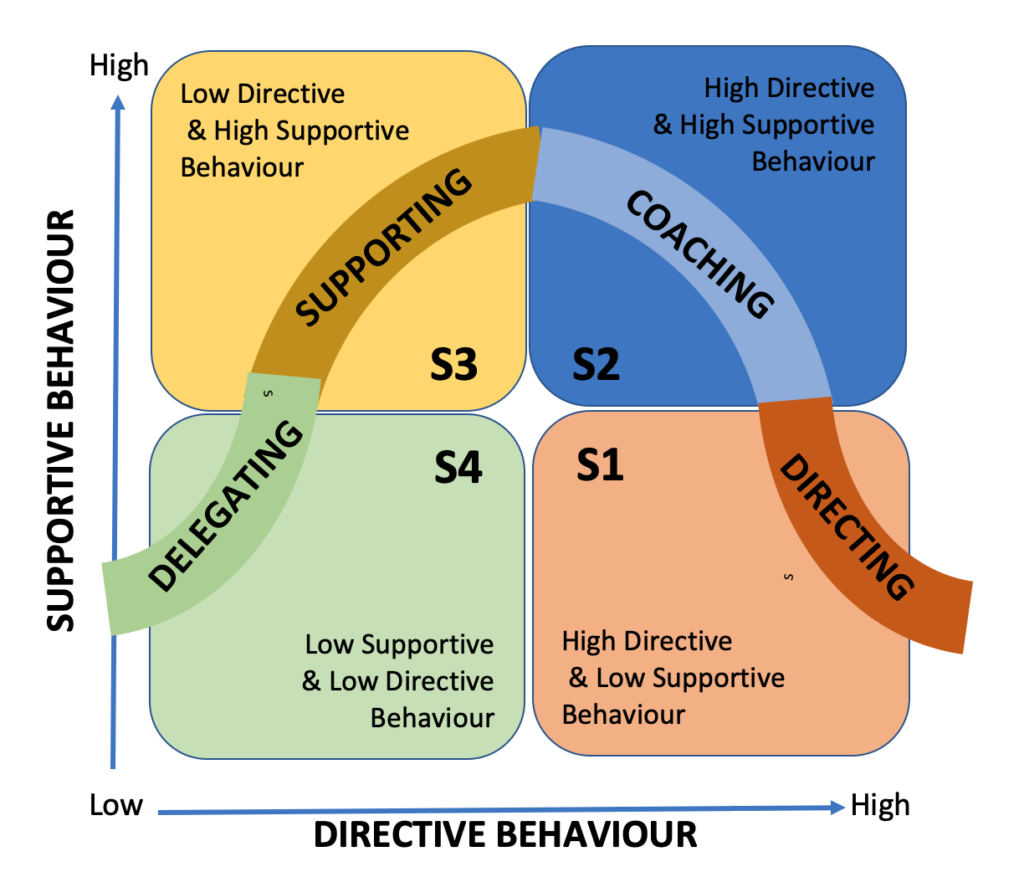
In 1982, Paul Hersey and Ken Blanchard published their book, “Management of Organizational Behavior: Utilizing Human Resources,” in which they presented their Situation Leadership model.
This model has become perhaps one of the most acknowledged leadership models in business. We’ll be looking at this model in today’s article. We’ll be looking to cover:
- What Is the Situational Leadership Model?
- Who are Hersey and Blanchard?
- Key Points of the Situational Leadership Model
- Benefits of the Situational Leadership Model
- Criticisms of the Situational Leadership Model
Let’s dive in…
What Is the Situational Leadership Model?
The key premise of the Situational Leadership Model is that different circumstances and situations drive diverse kinds of Leadership.
At the heart of the model is the requirement that a leader harmonizes their style to the proficiency and commitment of their subordinates.
To be an effective leader means that the individual must adapt their style to the demands of the situation they find themselves in and to what the organization requires. This adaptability is an intrinsic factor.
The situational leadership model can be defined as a strategy that:
- Considers the variables present in the workplace & the needs of the situation
- Encourages leaders to take stock of the members of their team
- Decide which leadership style is most supportive of the goals and circumstances of the organization.
The model has a straightforward construct that makes its use throughout an organizations hierarchy practical and straightforward, from senior-level executives through to lower-level managers.
Who are Hersey and Blanchard?
Paul Hersey (1931-2012) was an entrepreneur, educationalist, consultant, trainer, and a leading authority on situational Leadership and management. He also founded the Centre for Leadership Studies Inc. in 1960 with colleagues Carl Rogers and Douglas McGregor and had several degrees.
Ken Blanchard co-founded the Ken Blanchard Companies and is the Chief Spiritual Officer of this international management training and consulting firm, which started in 1979. He’s also an author, a speaker, a consultant, and a professor.
Key Points of the Situational Leadership Model
Within the context of the model, leadership style can be expressed as an algorithm comprised of two elements – Direction & Support.
The model’s key features are:
- It focuses on followers, not just workplace circumstances.
- Leaders can change their methods according to the type of followers they have.
- Leadership continually adapts to suit the development of followers.
This model uses the highs and lows of two criteria (via a 2×2 matrix), which classifies Leadership into four unique types.

The follower members of each group have different levels of experience and skill. The result is a more individualistic approach so that followers can reach their full potential.
What is a Leader?
According to the model, leaders must adapt to the type of followers they’re working with. They can do this by finding a balance between two behavior types.
1/ Directive behaviour
This refers to the leader who puts emphasis on getting the job done and is more focused on the task.
2/ Supportive behaviour
This refers to the leader who is concerned with building and maintaining a good relationship with employees. This kind of leader pays attention to the needs, security, and personal well-being of employees so they can perform well.
By using these two behavioral methods, the model describes four styles of Leadership:
1. Telling or directing.
This leadership style has a higher emphasis on directive behavior than supportive behavior. The primary concern is the task, so they offer clear instructions and an explanation of the consequences of failing to perform the task. This is best suited for unable but willing followers.
2. Selling or coaching.
This leadership style has an equal emphasis on directive and supportive behavior. It’s best suited for willing but unable followers. In this case, the main focus should be to increase the skills and the confidence of employees.
3. Participating or supporting.
This leadership style has a higher emphasis on supportive behavior. The leader focuses on listening, praising, and interacting with followers. It’s best suited for followers who are able but unwilling.
4. Delegating.
This leadership style is low on both directive and supportive behavior, which means it’s a more hands-off approach to Leadership. This suits able and willing followers the best because they’re able to perform their tasks independently and are already confident, so the role of the leader is simply to monitor and provide support when necessary.
What Is a Follower?
A Follower can refer to
- A person
- An entire group in which the individual possesses similar attributes i.e.:
- experience
- capability,
- competence,
Types of Follower
The situational leadership model breaks followers into four categories:
1. Low Competence/Low Confidence and commitment
Termed unable and unwilling. This kind of follower is unable to perform tasks because they don’t have the proper skills to do well. They’re also unwilling to perform tasks or lack the self-confidence to do so.
2. Low Competence/High Confidence and commitment
Termed unable but willing. This kind of follower is also unable to perform tasks, but the difference is they’re willing to try. They are motivated to perform even if they lack the skills, knowledge, ability, or experience.
3. High Competence/Low Confidence and commitment
Termed able but unwilling. This kind of follower is most likely to perform tasks well because they have the skills they need. However, they don’t want to; they’re unwilling. This could be because they are unmotivated or nervous about performing the task because they need support and encouragement from the leader. Their self-esteem and confidence will grow, which leads us to the final level.
4. High Competence/High Confidence and commitment
Termed able and willing. This kind of follower is ready, able, and willing to perform their tasks. So, they’re experienced, confident in their abilities, and want to perform well. They’re also able and willing to take responsibility for their tasks.
Each of these four follower categories will require a different leadership style demonstrating the appropriate mix of task and relationship.
There are four styles:
- High task emphasis: Leader provides clear direction to followers regarding method & purpose.
- Low task emphasis: Leader provides certain freedoms to followers (they may decide themselves on methods and aims)
- High Relationship emphasis: Leader works closely with followers utilizing a sensitive approach.
- Low Relationship emphasis: Leader works with a level of remoteness, placing trust in followers.
Benefits of the Situational Leadership Model
The situational leadership models provide many different benefits, which is why over 14 million leaders and professionals around the world make use of it in their organizations.
Benefits include:
1. It offers a flexible approach to Leadership
2. It endeavors to facilitate productivity
2. It facilitates collaboration
3. It is adaptable
4. It encourages an emotional aspect of Leadership
5. It utilizes the maturity levels of team members within devising appropriate leadership styles. within the organization
Criticisms of the Situational Leadership Model
- It shows a specific North American style, and it doesn’t consider the priorities and communication styles of other cultures.
- Categories are very prescriptive and do not address ambiguity.
- It doesn’t approach the differences between demographics (e.g., age/sex)
- It doesn’t address how situational leaders can impact the achievement of long-term strategies and politics.
Summary
Overall, the situational leadership model provides a straightforward approach that’s easy to apply and can be highly beneficial.
The model shows us that effective leaders recognize what employees need and then change their style to meet them.
However, it’s not without its issues, which need to be considered when utilizing the method.
What are your feelings towards Leadership? Do you agree that a standard methodology can be applied? What’s your experience?
We’d love your feedback either in the comments section or via Twitter.
This article is part of our Management & Leadership guide.